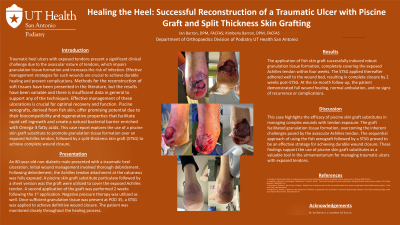Case Series/Study
(CS-011) Healing the Heel: Successful Reconstruction of a Traumatic Ulcer with Piscine Graft and Split Thickness Skin Grafting

Traumatic heel ulcers with exposed tendons present a significant clinical challenge due to the avascular nature of tendons, which impairs granulation tissue formation and increases the risk of infection. Effective management strategies for such wounds are crucial to achieve durable healing and prevent complications. This case report explores the use of a piscine skin graft substitute to promote granulation tissue formation over an exposed Achilles tendon, followed by a split-thickness skin graft (STSG) to achieve complete wound closure.
Methods:
A 80-year-old male presented with a traumatic heel ulcer with exposed Achilles tendon. Initial wound management involved thorough debridement and infection control followed by two intra-operative applications of a piscine skin graft substitute. Negative pressure therapy was utilized as well. Once sufficient granulation tissue was present, a STSG was applied to achieve definitive wound closure. The patient was monitored closely throughout the healing process.
Results:
The application of fish skin graft successfully induced robust granulation tissue formation, completely covering the exposed Achilles tendon within four weeks. The STSG applied thereafter adhered well to the wound bed, resulting in complete closure by 2 weeks post-STSG. At the six-month follow-up, the patient demonstrated full wound healing, normal ambulation, and no signs of recurrence or complications.
Discussion:
This case highlights the efficacy of piscine skin graft substitutes in managing complex wounds with tendon exposure. The graft facilitated granulation tissue formation, overcoming the inherent challenges posed by the avascular Achilles tendon. The sequential approach of using the fish xenograft followed by a STSG proved to be an effective strategy for achieving durable wound closure. These findings support the use of piscine skin graft substitutes as a valuable tool in the armamentarium for managing traumatic ulcers with exposed tendons.

.jpg)